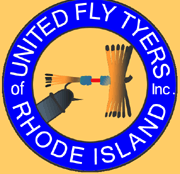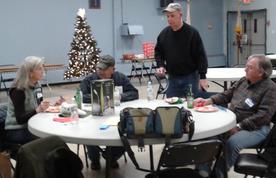United Fly Tyers of Rhode Island, Inc.
Calcasieu Pig Boat
Created by: Tom Nixon
ied by: John O'Meara
Hook: Heavy wire bass hook, size 2 to 2/0
Thread: Flat waxed nylon, your choice of color
Weight: Lead wire
Tail: Marabou, rabbit strip, saddle hackles, or rubber legs, in your choice of color
Body: Thick chenille, Crystal chenille, or estaz in your choice of color
Body hackle: Saddle hackle, your choice of color
Collar: Rubber legs, your choice of color
Eyes: (Optional) painted on side of thread head
You’ll notice from the recipe that you have a wide variety of choices in material. This fly can be tied for fresh water or salt water. As far as color combinations are concerned, use your imagination. If you think about it for a minute, when this fly was developed, (circa 1951), there weren’t cone heads, or speckled leg material available as we have today. Think of the wild combinations we can create today with the wonderful materials we have available. Go wild. Remember, we’re
going for bass here, not some wimpy, finicky trout.
Tom Nixon, of Louisiana, developed this fly years ago. Tom was an avid fly fisherman. He had friends who were into bass tournaments and used all sorts of bait. Tom wanted to develop a fly that would be as effective as some of the things they used. That’s how the “Pig
Boat” was born, and it did prove to be one of the most effective bass flies ever developed. “Pig boat” was the term used for German submarines in WW11. His favorite bass haunts were on the Calcasieu River in LA—hence “The Calcasieu Pig Boat.”
Since reading the article in the Autumn‘04 issue of Fly Tyer, I’ve come across several other articles about the fly. Tom did a lot of evaluation of different materials and hooks over the years. Apparently, he decided that the most effective hook for this pattern is a 1/0. If
motion in a fly is what causes a fish to strike, this fly is a winner. The chenille and hackle body is intended to be done heavily so it helps support the collar, and keep it undulating.
With a name like “The Calcasieu Pig Boat”’ how can it lose?


